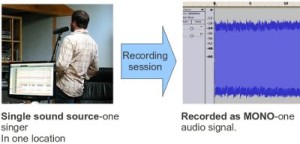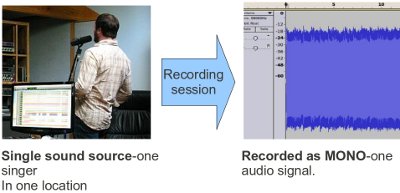Let me get this straight- a human voice is a mono instrument. And then you might asked, “Hey but I’ve seen engineers using two microphones, like in a choir, jazz ensemble or classical performance, isn’t it an example of recording vocals in stereo”? This question requires an in-depth explanation.
First, an audio recording signal can either be mono or stereo. Mono is one channel audio while stereo is a two channel audio. A digitized audio recording signal is the one stored in your computer. Second, a sound source can either be single or multiple. A single sound source is obviously originating from a single instrument at a single location. A multiple sound source originates from different instruments and location. This sound source is outside your recording software. Common example of sound source is the music or the singing performance that you would like to capture. Failing to understand mono and stereo can even confuse you further. It’s actually very simple.
Mono – one sound source, one location. This is the simplest way to understand a recorded mono signal. Now its very clear, if you are recording the vocal performance of a single singer at the vocal booth, you should be recording it in mono because the nature of the signal is mono.
One common mistake is that even though the sound source is “mono” in nature, you are recording it in stereo. This mistake originates in your recording software or audio interface settings. If the sound source is mono, you should configure your digital audio recording software to record it as mono as well. This is easy to configure in most software. For example, in this Reaper DAW tutorial; you will learn how to configure Reaper to record the vocals in mono.
Or if you are using the free recording software like Audacity, you can refer to this tutorial on how to record using Audacity. This is mono recording of vocals in Audacity:

Stereo– two distinct sound sources, different location OR multiple sources in different location summed up to two audio recording signal (left and right). If the vocal performance is more than a single sound source; of course the nature of sound is not mono anymore; instead this is where you start treating them as stereo.
A classic example is choir performance(two or more singers performing together). If a person is standing in front of the performing choir(such as the conductor); that person can hear the multiple sound sources with sound waves entering both on his left and right ear. The combined effect is stereo and distinct “mono” sound sources enter the left ear and the right ear. There are actually two ways the engineer can capture this performance.
First method: The engineer will place two microphones in front of the choir (for small choir such as less than 15 persons). Each of this microphone is equivalent to one mono signal. These microphones are then plugged into the mixer. Using an outboard mixer; the engineer will mix these two mono signals and then summed it up to “stereo”. The engineer can then route this recording to a recording software. As a result, the audio recording is in stereo.

But the engineer is actually recording each vocals captured in each microphone in mono. Thus you need to understand that a stereo can as well be defined as “two distinct mono signals”. Its because one microphone equates to one sound source and one sound source corresponds to a single channel mono audio recording signal. And also take note that the left and right mono channels does not contain same information, they are “different”. The primary reason is that they are coming from two different sound sources (one microphone might strongly capture the soprano performance while the other microphone on the tenor performances).
Second method: The other method is to directly record two mono vocal sound sources to your DAW and then mix within your software. For example:

In the above example the two microphones corresponds to two sound sources that results to two mono signals recorded together in your DAW. The first mono signal is on track 1 and the other on the track 2. This is called a simultaneous multichannel recording technique. For more details about this technique, you can read this tutorial on how to do a multi-track recording session.
Or if you are using Reaper, you can directly record in stereo. This is how to configure below:

You need to select INPUT: Stereo options. As you can see it requires two inputs from your audio interface. Each of these inputs are coming from two different microphones as described earlier.
Summary: Always record vocals in mono for most projects but..
In this tutorial on how to record vocals properly; most home studio vocal recording projects should be done in mono unless you are recording a chorale or a group of singers where stereo recording makes sense.
To deal with this, you need to assign mono tracks for every singer/vocalists in your project. Supposing you are recording a band with one lead vocalist and two backup vocalists. You can create 3 separate vocal tracks in your DAW which are as follows:
Track #1: Lead vocal – mono
Track #2: Backup vocal 1 – mono
Track #3: Backup vocal 2 – mono
In this method, you can easily apply effects to each of the vocal tracks.
Content last updated on June 20, 2012









3 Responses
Hello!
Thanks a lot. I’ll try this when I get home.
Mon
Hi Mon,
Go to Edit View and click F11 or go to Edit — Convert sample rate, you can configure to convert the mono to stereo.
Hello Emerson!
Just a simple question, (i suddenly had mental-block).
I used to record vocals in a mono-track in Audition also. But suddenly, I forgot how to record in mono and then later make it output into stereo.
Because, obviously, when I record in mono, and play it back, it will only output to either left or right of my cans. How do I make the mono to stereo?
I honestly, just suddenly forgot how. 🙂
thanks again for your help!